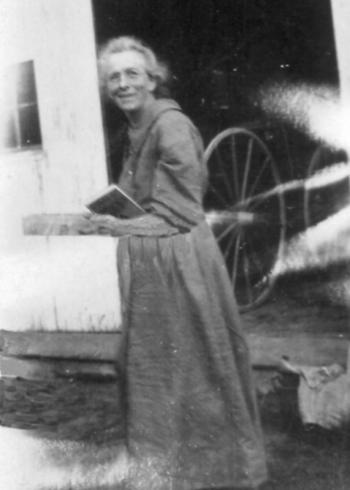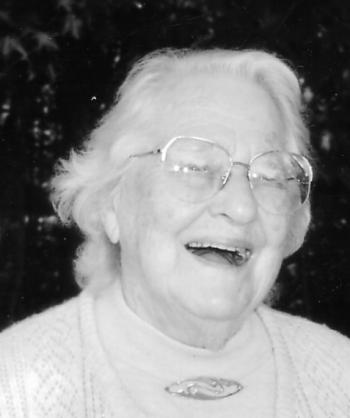This Week in Lincolnville: Remembering Margaretta
A large stoneware crock was already half-filled with greens, and now she added these to the top, sprinkling each layer liberally with salt from a box. When all were packed she placed a plate on top, pressing it down firmly. Ralph would lug the crock down cellar later, and then she’d top it off with the rock she kept down there for just that purpose. She dried her hands on her apron. Time to check on the cow, she thought.
Stepping out the kitchen door the sun felt warm on her shoulders, reminding her that spring had finally arrived. People living in Maine paid no attention to the calendar, which insisted the first day of spring was sometime in March. Everyone knew March meant mud season, not spring. But now that it was May, Hattie would entertain the idea that winter was truly over.
The land had been part of the Fernald Neck farm, Hattie’s childhood home. Her family always called this 36-acre piece the “further field”, and Hattie remembered when it was a mowing field, when the men cut it with hand scythes. After her father died in 1891, her mother deeded the field to her. Now Hattie’s oldest sister, Anna, lived further down the Neck on the home farm with her husband, Orris Harkness, and their children, Elizabeth and Vinton. Their other sister, Emeline, lived in Colorado. She stopped and surveyed her surroundings—fields, Lake Megunticook and the Camden Hills beyond. Including the house, which she and Ralph had built some 20 years ago—this scene was her whole world.
It wasn’t as though Hattie had never been anywhere else, though. After she finished the eighth grade at the Youngtown School, she and her two sisters went to Medfield, Mass., where they worked in a straw shop for a winter. That had been a challenge, mastering the machines that turned sheaves of straw into neat, narrow braids, and those braids into straw hats. She wasn’t sorry she’d done it, but she wasn’t sorry to come back home either.
Still, she wasn’t quite ready to settle down. Next she went out to Islesboro, obtained a certificate to teach, taught a term on Seven Hundred Acre Island, and ended up marrying one of her pupils! Hattie smiled to herself; there was a little more to the story than that. She’d boarded with Charlotte Warren whose son, Ralph, was an occasional pupil. Since he often went sailing on coastal schooners with his father, Captain Jeremiah Warren, he’d only attended school during the winter term. Ralph was just her own age, and was finishing up his schooling the year she taught on the island. They were both 21 when they got married.
From the beginning, Hattie knew she hadn’t married a farmer. Just as she was attached to the land and the animals, Ralph was a sailor by birth—except that the mariner’s way of life was passing with the end of sail. Fortunately, Ralph was mechanically-minded, and had early found his vocation as a steam engineer. He often worked on the beam trawlers that fished the Grand Banks. Just now he’d been gone a week, and Hattie didn’t expect him back for another two weeks at least. When he wasn’t out on the trawlers, he sometimes worked for the Eastern Steamship Line on their Boston run.
So she became the “farm lady”, planting and tending the garden and carrying water to the animals every morning. She got their grain at the grist mill on Camden’s Main Street [where the Smiling Cow is nw located]. She smoked hams from the pig in a barrel with corncobs and stored the fresh pork down cellar in brine. When she had a beef critter, she canned the meat or hung it in the barn during cold weather. She even knew how to make tripe, cleaning the stomach of the newly-slaughtered beef in the brook and then pickling it. She did the milking and cared for Dick, the dappled gray. Dick pulled the mowing machine, did the plowing and pulled the wagon, and in winter, the sled.
Their first three children—Lyla, Lucy and Hilda—came along one after another between 1892 and 1897. When a boy, Fernald, arrived in 1903 they were certainly pleased. By then they were living on the “further field” in the house that Oscar Young, with Ralph’s help, built for them. They thought their family was complete, when they got a surprise in 1911—a baby girl! Hattie and Ralph were 41 years old.
Hattie decided to name this baby for the Polish woman, Margaretta Domincovitch, who once boarded at the Fernald farm. So Margaretta she was. Lyla and Lucy were nearly out of the house by that time, and Hilda and Fernald were in school. It was almost like having an only child.
Hattie had more time to spend with this last child, not that Margaretta wasn’t able to learn things on her own. Why, she had a little bird book and already she’d taught herself to identify all the warblers that lived in their fields and woods by their song alone. She certainly was a child to amuse herself. Just now the children in the neighborhood—Fred and Carrie Hardy’s children down the road, their Carver cousins from up on Youngtown, along with Margaretta—were busy hanging homemade May baskets on doors up and down the roads, then running and hiding. Hattie remembered doing the same thing when she was a girl.
CALENDAR
TUESDAY, May 5
Budget Committee Public Hearing, 6 p.m., Town Office
WEDNESDAY, May 6
“Waking Up the Garden”, 7 p.m., Lincolnville Library
THURSDAY, May 7
Free Soup Café, noon-1 p.m., Community Building, 18 Searsmont Road
FRIDAY, MARCH 13
Children’s Story Time, 10 a.m., Lincolnville Library
Every week:
AA meetings, Tuesdays & Fridays at 12:15 p.m., Wednesdays & Sundays at 6 p.m.,United Christian Church
Lincolnville Community Library, open Tuesdays, 4-7, Wednesdays, 2-7, Fridays and Saturdays, 9 a.m.-noon. For information call 763-4343.
Soup Café, every Thursday, noon—1p.m., Community Building, Sponsored by United Christian Church. Free, though donations to the Good Neighbor Fund are appreciated
Schoolhouse Museum open by appointment only until June 2015: call Connie Parker, 789-5984
COMING UP
May 14, Community Dance, LCS, 6 p.m.
May 16, Indoor Flea Market, 8-noon, Community Building
May 17, Pastor Mair Honan, 9:30 a.m., UCC
May 17, Photographic exhibit, 3 p.m., Community Building
May 18, Oldtimers lunch, 11:30 a.m., Lobster Pound
May 19, Special Town Meeting, 6 p.m., Walsh Common
May 21, L.I.A. meets, 5:30, L.I.A. Building
May 26, CSD Budget meeting,CHRHS
June 9, Election Day
June 11, Annual Town Meeting
March 26 & 27 – Blarney & Balderdash, an Irish play performed by a cast of 40 from grades 2-8
Margaretta may have been raised as an only child, but she wasn’t lonely. She and Evelyn Hardy were great friends, playing dolls and Indians and who knew what other games. Evelyn’s dolls were fancier, Hattie knew; Margaretta’s were more likely homemade, but it didn’t seem to matter to either child.
Hattie did worry some about the lake being so close, but then she’d raised five children within sight of it; she had her rules. No child was allowed to go near the water without telling her first. It taught them two things—to respect the water and to soothe her worrying. In some ways the winter was more of a concern. The ice could be so deceptive, and the children heedless when they got to skating with their friends.
One year Millard Crooker slid right into the water at a thin spot; fortunately, Fernald was nearby and was able to pull him out. Margaretta, like her sisters and brother, knew where the weak spots were likely to be and avoided them. The child pointed out to her mother how the hornpout came to the surface in a frenzy when there was open water.
Hattie stirred herself from her reverie in the spring sunshine. What about the cow? She stepped inside the barn and looked over to the little Jersey cow, and next to her, a still-wet newborn. Its mother was busily licking it dry, her rough tongue thrusting against the tiny thing. The calf must have arrived while she was preparing the dandelions. She’d checked when she’d finished digging them, and just noted that the cow seemed restless. It was too bad humans couldn’t give birth with so little fuss.
The calf had struggled to its feet and now stood unsteadily on its splayed legs. Hattie smiled, watching its first gropings toward the udder. With this one coming fresh, she had three cows to milk, plenty of rich Jersey milk for her butter and cottage cheese, and lots left over for the pig and chickens. It was just what she expected on the first real day of spring.
Read more stories about our town in Staying Put in Lincolnville, Maine 1900-1950, available at Western Auto, the Lincolnville Community Library, and at Sleepy Hollow Rag Rugs, 217 Beach Road.
This story is based on several long conversations with Margaretta Warren Thurlow, Hattie and Ralph’s “surprise”. All the details — from the family history to the crock of greens, even the rock kept special to weigh it down — came, matter of factly, from her memory. I took those facts and, as I did with all the stories in Staying Put, made up a little vignette that gave the character a likely chance to ruminate on that history. In the first version Hattie was out looking for the cow, suspecting she’d gone off to have her calf, and was overcome with the beauty of the May day. She sat down on a rock, where she recalled the story of her own life.
I took the finished piece to Margaretta and read it to her (as I did with each of the stories in that book and their subjects), wanting to make sure it was accurate.
“She never would have done that!” Margaretta scolded me. “That’s just not her! Sit down and day dream? No!”
And that little exchange tells you who may not have known her, a lot about Margaretta. If you’re lucky enough to have, though, you can probably still hear her firm, slightly annoyed voice, setting me straight.
Margaretta Thurlow lived and died in the house she was born in, the house her parents built on the Fernald Neck Road.
Her mother, Hattie, died when her youngest daughter was just 12; Margaretta went to live with her aunt and uncle in Veazie so she could attend Bangor High School. From there she went to the University of Maine and became the first woman to graduate, in 1938, with a degree in horticulture. That led to jobs with the W. Atlee Burpee seed company in Pennsylvania and later Iowa.
By 1952 she was back home on Fernalds Neck for good; the next 20 or so years she worked for Downeast Magazine. Many remember Margaretta for her significant role in the Fernald Neck Preserve, including a donation of 30 acres in memory of her mother.
Margaretta was a knowledgeable gardener, wise about both animals and plants, proud of her heritage. She was a force, a woman confident in herself. Losing her mother at such a young age, leaving home for her education, I think she learned early to rely on herself. When she married a childhood friend, Royce Thurlow, in her 40s, it was time to come home. They set up housekeeping in her parents’ house and began raising chickens. All that came to an end a short seven years later, when Royce died suddenly of an infection, leaving her alone once more. For a time, she told me, she “howled” at the injustice of it out in her garden. I don’t imagine that as self-pitying; Margaretta wasn’t that way.
I knew her in her 80s and 90s; I was a little scared of her. I’d never known a woman like her, so sure of herself and of her opinions. Sometimes her beliefs and practices could seem at odds. She used to sit on her porch and shoot the squirrels that raided her bird feeders. When she could no longer shoot (did someone take away her gun?) she trapped them, then hauled the trap to the bathtub and drowned them. She was a Maine woman.
One day she called to ask if we used 100 percent cotton for the warp in our rugs. Could she have some for the birds? She explained that she liked to leave pieces of string out for the birds, especially the Orioles, to use in their nests; the birds preferred all cotton to synthetics, she assured me. For several years I saved pieces for her. When I found a tiny nest made entirely out of our pony’s tail hair, I took it to Margaretta, and she identified it as a chipping sparrow nest.
When horses were common on every farm, she told me, chipping sparrows would always prefer their hair for their nests. This spring my granddaughter, Lucy, helped me put out string on the bushes in our yard; we think it was all taken.
When she suffered a stroke and found herself in Quarry Hill, she was not pleased. After weeks and weeks, maybe months, of rehab — I doubt many her age worked as hard — she finally got her way and went home, against the better judgment of family and friends. She got her wish, (I’m sure it was her wish; I’ve now known so many who wish it) to die at home. It was 2009; she was 97.
As for the story about her mother, Hattie, I took it home that day and gave Hattie something to do; cleaning dandelion greens seemed what a farm woman would be doing on a May morning. Luckily, Margaretta agreed.
All I know about dandelion greens
If you don’t count maple sugaring we’re now into the first harvest of the year — dandelion greens. Unless you’re a Mainer or a country-bred person you’re probably as mystified as I once was about a plant most of us consider a weed. But if you love to try new foods and/or foraging for something free and plentiful, dandelion greens are no further away than your own dooryard.
You’ll need two pieces of equipment — a paper bag and an old paring knife. Any old dandelions will do as long as they haven’t sent up flower stalks yet. Look for tight, flat rosettes of leaves with buds still snug in the middle. Plunge the knife down alongside the plant, and on a diagonal, slice through the root. Pull up the plant which should be intact with a couple of inches of brown root below.
Now here’s the crucial part. Cut off all but about 1/4 inch of the brown root so the rosette of leaves doesn’t fall apart. Pull off all the dead leaves and any debris such as grass and junk clinging to the plant. Rub off as much mud as you can with your fingers. Only then should you put the dandelion in the bag. Do most of the cleaning out in the sunshine and you won’t have to spend as much time at the sink.
When you’ve got enough for a meal (it takes lots, for greens cook down tremendously) head for the kitchen and a panful of cold water. Dump in the dandelions and swish them around vigorously. Change the water two or three times. Finally, cut off the remaining brown root and wash one more time. Some plants will come apart; be sure to keep the buds as well as the leaves. Now drain them.
Partially fry 1 piece of bacon per diner; I like the bacon less than crisp. Cut it up into small pieces. Now dump the greens in to a pot that has a tight lid, add 1/2 to 1 cup of cold water, the bacon AND the grease. I know, I know. We always drain the fat. But not when you’re cooking dandelion greens. Oldtimers always put a big piece of salt pork in there, and we’re not going to do that.
Now, just cover the pot and cook on high heat for 10 to 15 minutes. Divide the cooked greens into bowls and pour the “pot liquor” over them. Serve with vinegar on the side. That’s it. (Wally says cook a few potatoes along with the greens in the same pot: good idea!)
Waking up the garden
Emilia Carbone and Jed Beach will present a free program on “Waking Up the Garden for Spring” on Wednesday, May 6, at 7 p.m. at the Lincolnville Community Library. Jed and Emilia are the owners of 3 Bug Farm in Lincolnville, where they grow a wide variety of organic vegetables. They will cover topics important for home gardeners such as soil fertility, weed management, season extension and planting techniques. They will also share their experiences running their own farm. For more information, call 763-4343 or email.
Community dance at LCS
Partners for Enrichment invites the community to an evening of music and traditional New England dance for the whole family with caller Chrissy Fowler and the Belfast Bay Fiddlers, Thursday May 14, 6-7:30 p.m. at Lincolnvillle Central School. Sounds like a perfect spring celebration! Partners for Enrichment is an all-volunteer nonprofit celebrating 18 years of providing arts and science enrichment for the K-8 schools of Lincolnville, Appleton, and Hope.
Indoor flea market
The first Indoor Flea Market of the season will be held at the Community Building Saturday May 16, 8 a.m.-noon. This is a fun Market, held the third Saturday of each month, May through October, with a variety of vendors with antiques, food, collectibles, and handcrafts. Contact Manager Mary Schulein, 785-3521, if you’re interested in a table.
Old timers lunch
Next Monday, May 18, Lincolnville oldtimers will gather at the Lobster Pound at 11:30 for lunch and conversation. This semi-annual event was originally set up for folks who’d all grown up together at the Beach, but over the years it’s grown to include our whole town. If you’d like to come, you’re welcome to, just contact Janet Plausse, 789-5811, as she’s keeping count.
Special town meeting
On Tuesday, May 19, 6 p.m. a special Town Meeting will consider and vote on the LCS budget for the coming year.
Lincolnville Improvement Association
The first L.I.A. meeting of the season will be held Thursday, May 21 at 5:30, L.I.A. Building, 33 Beach Road. The L.I.A. is well-known for its delicious pot luck dinners. All are welcome, members or not; bring a dish to share if you can.
Guest preacher
Pastor Mair Honan will be speaking at the Sunday, May 17 worship service at United Christian Church. All are welcome; the service begins at 9:30 a.m.
‘These Hands’
An exhibition of works by Portland photographer, Jane Fairbrother, will be on display for one day only, Sunday, May 17, from 3:00 - 4:15 p.m. in the Lincolnville Community Building. The photographs were taken as Jane walked with Pastor Mair Honan on her daily rounds ministering to the marginalized and homeless of Portland. People of the street volunteered to have their hands photographed and tell their story. The photographs and stories have been compiled in the book These Hands. Proceeds from the sale of the book benefit Grace Street Ministry. Grace Street was co-founded by Rev. Karen Christensen and Pastor Honan in 2006, shortly after Mair was ordained at the United Christian Church (UCC) in Lincolnville Center. UCC provides ongoing support for Grace Street. Previous to starting her ministry, she was a counselor in the midcoast area and with her husband, Paul, raised their family in Lincolnville.





























